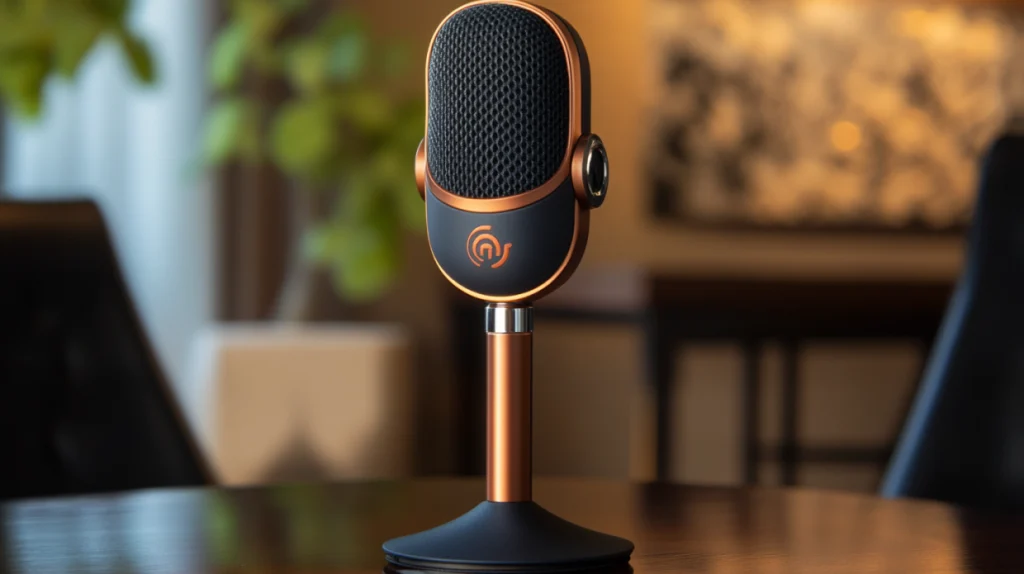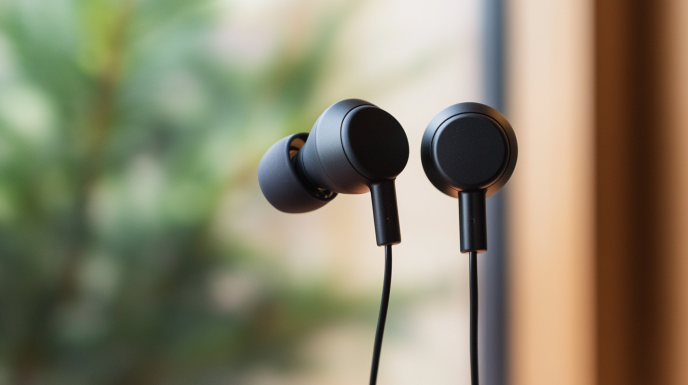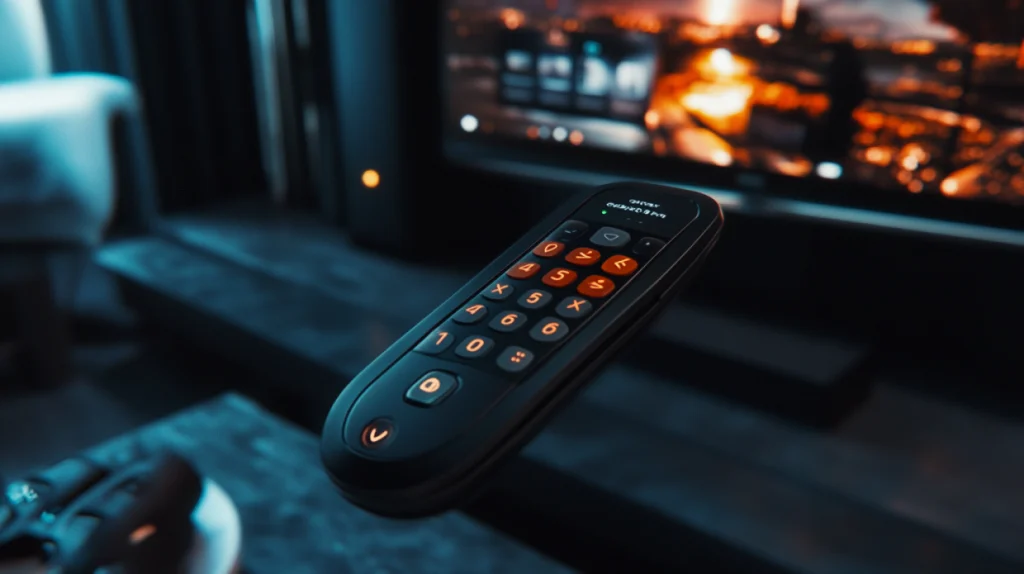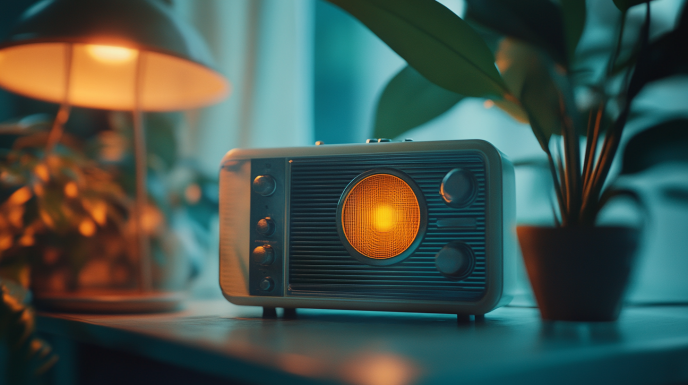
QFX M-158 Professional Dynamic Microphone
- • Dynamic unidirectional microphone
• Handheld microphone ideal for live vocals
• Designed for professional vocal use
• Effective built-in spherical wind & pop filter
• XLR professional audio connector
• Freq resp: 60Hz–13kHz
• Sensitivity: -70dB
• Includes carrying case, cable & stand mount
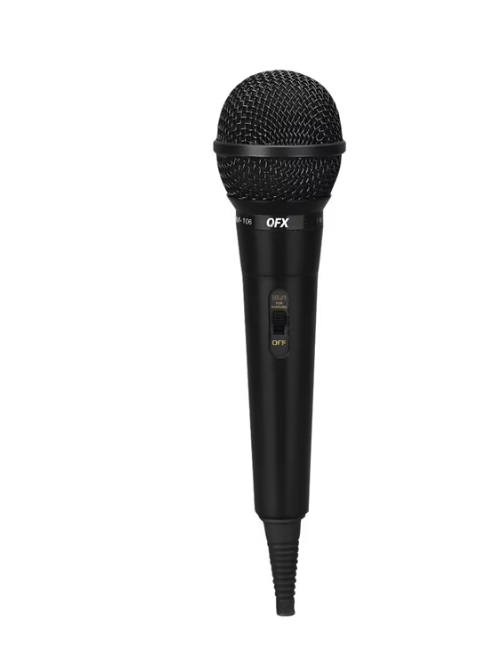
QFX M-106 Unidirectional Dynamic Microphone with 10-foot Cable
- Unidirectional
- Dynamic
- Includes 10 ft. Cable with silver-plated 1/4 in. Jack
- Black
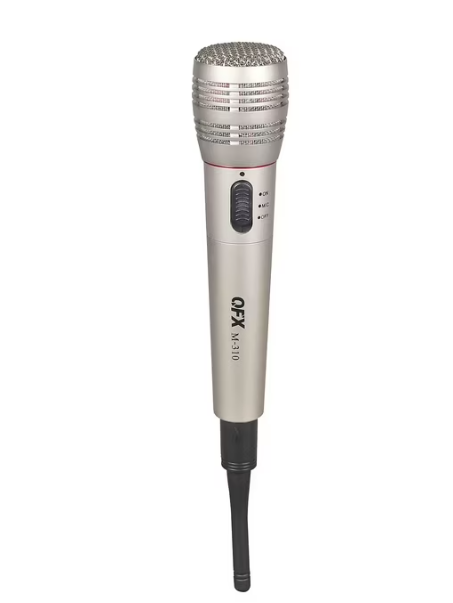
QFX M-310 Dynamic Professional Microphone
- Unidirectional dynamic microphone, Frequency response: 100 Hz to 1,000 Hz, Sensitivity: -72 dBImpedance: 600 ohms, Operates on 1 AA, Effective distance: 49 to 98 ft. (15 to 30 m), Includes 2 AA , receiver, wrless antenna, and cable, Includes carrying case, cable & stand mount
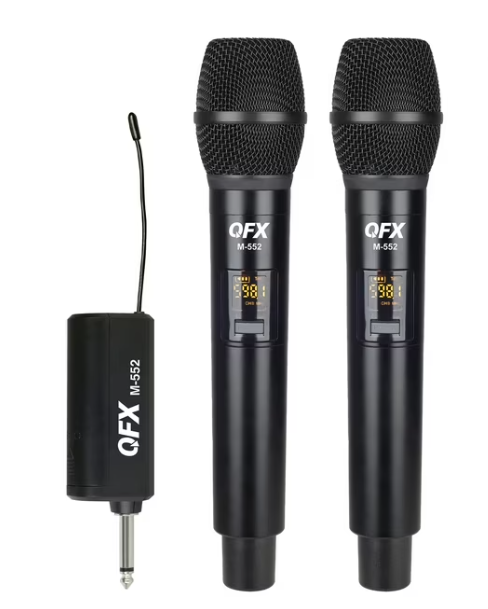
QFX M-552 16-Channel UHF Multi-Frequency Microphone System with 2 Handheld Microphones and Dual-Channel Plug-in Receiver, M-552
- System includes 2 wireless handheld microphones with built-in transmitters and 1 dual-channel wireless receiver with 1/4-in. TS plug
- 16 channels; frequency selectable with auto pairing between microphones and receiver
- Operating range between 98 ft. (30 m) and 164 ft. (50 m), depending on environmental factors
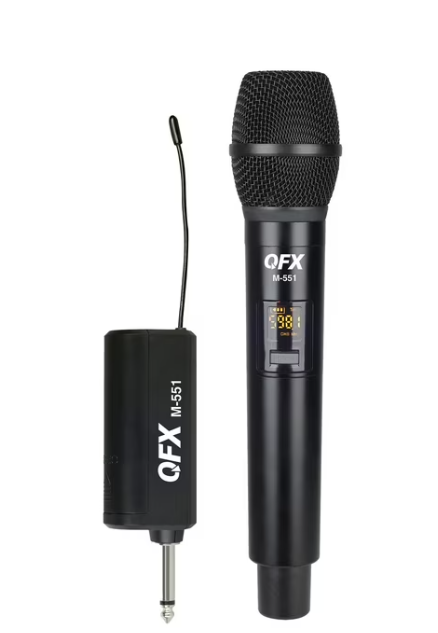
QFX M-551 16-Channel UHF Multi-Frequency Microphone System with Handheld Microphone and Plug-in Receiver
- System includes wireless handheld microphone with built-in transmitter and wireless receiver with 1/4-in. TS plug
- 16 channels; frequency selectable with auto pairing between microphone and receiver
- Operating range between 98 ft. (30 m) and 164 ft. (50 m), depending on environmental factors
- Microphone uses 2 AA batteries; receiver uses Li-Ion rechargeable battery
Unleashing Your Voice: How QFX Microphones Are Changing the Audio Game
In today’s audio-driven world, finding the right microphone can make all the difference between amateur sound and professional-grade audio. Whether you’re hosting a karaoke night, planning your podcast debut, or addressing a room full of people, the quality of your microphone is just as important as what you have to say. Enter QFX microphones – affordable, versatile audio tools that have been gaining popularity among hobbyists and professionals alike.
As someone who’s spent countless hours testing various audio equipment, I’ve developed a particular interest in accessible audio gear that delivers quality without breaking the bank. QFX has positioned itself uniquely in this market space, offering solutions for various audio needs while maintaining affordability.
But is a QFX microphone right for you? Where can you purchase one? How does it compare to industry standards like Shure or Samson? In this comprehensive guide, we’ll explore everything you need to know about QFX microphones, from specifications and connectivity options to troubleshooting tips and real-world applications.
Where to Find Your Perfect QFX Microphone
Finding a QFX microphone is relatively straightforward, as they’re available through multiple retail channels. Unlike some boutique audio brands that limit their distribution, QFX has embraced a wide-reaching approach to ensure their products are accessible to everyone.
Major electronics retailers like Best Buy occasionally carry QFX microphones in their audio equipment sections. However, the most reliable places to purchase QFX microphones are online retailers. Amazon offers perhaps the most extensive selection of QFX microphones, with various models available for different purposes. Walmart, both online and in select physical stores, also stocks QFX audio equipment, including their popular microphone models.
For those who prefer to shop directly from the manufacturer, QFX’s official website provides a catalog of their microphone options, though prices may be slightly higher than third-party retailers due to the absence of competitive discounting.
Specialty electronics stores and music shops sometimes carry QFX microphones as well, particularly in areas with active music or performance communities. These venues offer the added benefit of knowledgeable staff who can provide guidance on which model might best suit your needs.
If you’re budget-conscious or looking for a deal, keep an eye on seasonal sales events like Black Friday, Cyber Monday, or back-to-school promotions, when QFX products are often discounted significantly across multiple retailers.
Wired vs. Wireless: Understanding QFX Microphone Options
One of the most common questions about QFX microphones concerns whether they’re available in wired or wireless configurations. The answer is both – QFX offers a variety of microphone types to suit different needs and preferences.
QFX’s wired microphones connect directly to your audio equipment via a physical cable, typically with a standard 3.5mm audio jack or XLR connector depending on the model. These wired options tend to be more affordable and eliminate concerns about battery life or signal interference. They’re ideal for stationary use in home studios, karaoke setups, or permanent installation in venues where mobility isn’t a priority.
The wireless QFX microphone line has expanded considerably in recent years, responding to growing demand for untethered audio solutions. These models typically use UHF (Ultra High Frequency) technology to transmit audio signals to a receiver unit. The receiver then connects to your amplifier, speaker, or recording device. The freedom of movement offered by wireless QFX microphones makes them particularly valuable for presenters, performers, and active content creators who need to move around while maintaining consistent audio quality.
It’s worth noting that some of QFX’s newest microphone models incorporate dual functionality – they can operate both wirelessly and with a wired connection when necessary. This versatility provides a backup option if batteries run low or if you encounter interference in particularly crowded radio frequency environments.
The Price Point: Are QFX Microphones Worth the Investment?
QFX has built its reputation on offering audio equipment at accessible price points, and their microphones are no exception. The cost of a QFX microphone varies depending on the model, features, and whether it’s wired or wireless.
Entry-level QFX wired microphones typically range from $15 to $30, making them an economical option for beginners or casual users. These basic models usually include a simple on/off switch and a standard connector, providing straightforward functionality without advanced features.
Mid-range QFX microphones, which often include wireless functionality and improved audio quality, generally cost between $40 and $80. At this price point, you can expect features like adjustable gain control, basic noise reduction, and reliable wireless range suitable for average-sized rooms.
The premium QFX microphone offerings, priced between $90 and $150, incorporate more sophisticated technology such as enhanced wireless range, superior noise cancellation, longer battery life, and better frequency response for more accurate sound reproduction.
When comparing the value proposition of QFX microphones to more established audio brands, it’s important to consider your specific needs. While premium brands like Shure or Sennheiser offer microphones with exceptional technical specifications and durability, their entry models often cost as much as QFX’s premium offerings. For casual users, hobbyists, or those on a tight budget, QFX microphones deliver impressive performance-to-price ratio that makes quality audio accessible to everyone.
Range and Reliability: How Far Can You Go With A QFX Wireless Microphone?
For those considering a wireless QFX microphone, understanding the effective range is crucial to determining whether it will meet your needs. The range of QFX wireless microphones varies by model, but most operate effectively within a 30 to 100-foot radius from the receiver under optimal conditions.
Entry-level QFX wireless microphones typically offer reliable performance within a 30 to 50-foot range, making them suitable for small venues, classrooms, or home use. Mid-range models extend this coverage to approximately 60 to 80 feet, providing adequate range for medium-sized spaces like community halls or larger living areas.
The premium QFX wireless microphone models advertise ranges of up to 100 feet or more, though it’s important to understand that these specifications assume ideal conditions with minimal interference. Physical obstacles like walls, large metal objects, or electronic equipment can significantly reduce the effective range.
Most QFX wireless microphones operate on UHF frequencies, which generally offer better penetration through obstacles than VHF alternatives. However, in environments with significant wireless congestion, such as urban areas or spaces with multiple electronic devices, you may experience occasional signal dropouts even within the specified range.
Some of the newer QFX wireless microphone models include auto-scanning features that automatically select the clearest channel for operation, which helps maximize range and reliability in challenging environments. For critical applications where consistent wireless performance is essential, it’s advisable to test your QFX microphone in the actual environment where you’ll be using it, rather than relying solely on the manufacturer’s specifications.
Connecting Your QFX Microphone: A Step-by-Step Guide
Setting up your QFX microphone correctly ensures optimal performance and sound quality. While the specific connection process varies slightly between models, here’s a general guide to connecting different types of QFX microphones to speakers or audio equipment.
For wired QFX microphones with a 3.5mm connector:
- Ensure your speaker or audio device is turned off to prevent feedback
- Locate the microphone input on your device (often labeled “MIC” or with a microphone icon)
- Insert the 3.5mm plug firmly into the microphone input
- Turn on your audio device and adjust the volume gradually
- Speak into the microphone to test the connection and adjust settings as needed
For QFX microphones with XLR connectors:
- Connect one end of an XLR cable to the microphone
- Connect the other end to the XLR input on your mixer, audio interface, or PA system
- Ensure phantom power is activated if your QFX model requires it (check your manual)
- Gradually increase the gain or volume control while testing the microphone
For wireless QFX microphones:
- Position the receiver unit near your audio equipment, ideally elevated and away from metal objects
- Connect the receiver to your audio device using either the included 3.5mm cable or XLR connection
- Insert batteries into the wireless microphone (typically AA or AAA depending on the model)
- Power on both the microphone and the receiver
- Wait for the indicator lights to show successful pairing (usually a steady light rather than flashing)
- Test the microphone at various distances to ensure reliable connectivity
For QFX microphones with Bluetooth functionality:
- Turn on the microphone and activate its Bluetooth pairing mode (usually by holding a dedicated button)
- Enable Bluetooth on your playback device (smartphone, tablet, or computer)
- Select the QFX microphone from the list of available Bluetooth devices
- Once connected, select the microphone as your audio input device in your recording or communication app
- Test the connection by speaking into the microphone while monitoring through your device
The key to successful QFX microphone connectivity is ensuring proper signal routing and appropriate volume levels to prevent both feedback and distortion while maintaining clear audio reproduction.
Karaoke Champions: QFX Microphones and Singing Machines
QFX microphones have earned particular popularity in the karaoke community, largely due to their compatibility with a wide range of karaoke systems and their affordability for casual entertainers.
Most QFX microphones work seamlessly with standard karaoke machines thanks to their conventional connectivity options. The typical 3.5mm connector found on many QFX wired microphones plugs directly into most consumer karaoke systems without requiring adapters or special configurations. For higher-end karaoke setups that use XLR inputs, QFX offers compatible microphone models or you can use a simple adapter.
QFX wireless microphones are especially popular for karaoke applications since they allow performers to move freely while singing. Many karaoke enthusiasts appreciate that they can purchase multiple QFX wireless microphones that operate on different frequencies, enabling duets or group performances without investing in expensive professional equipment.
Some QFX microphones designed specifically for karaoke include built-in echo effects, which add a professional-sounding reverb to vocals – a feature particularly appreciated by karaoke hosts and enthusiastic singers looking to enhance their performances. Several models also incorporate volume controls directly on the microphone body, allowing singers to adjust their levels without returning to the main karaoke unit.
For those using smartphone or tablet-based karaoke apps, QFX offers microphones with Bluetooth connectivity that pair directly with these devices, eliminating the need for physical connections and expanding the versatility of modern karaoke setups.
Bluetooth Capabilities: Cutting the Cord with QFX
As wireless technology has become increasingly prevalent, QFX has responded by incorporating Bluetooth functionality into select microphone models. These Bluetooth-enabled QFX microphones offer additional flexibility and convenience for users who prefer wireless connectivity or who work primarily with mobile devices.
The Bluetooth capability in QFX microphones typically allows for two primary functions. First, it enables the microphone to connect wirelessly to Bluetooth-compatible speakers, smartphones, tablets, or computers for audio input. Second, some models can also receive audio from a Bluetooth source, combining microphone input with background music for karaoke or announcement applications.
QFX Bluetooth microphones generally use Bluetooth 4.0 or 5.0 technology, providing effective range of approximately 30 feet under typical conditions. This range is sufficient for most indoor applications, though walls and electronic interference can reduce the effective distance.
Pairing a Bluetooth QFX microphone is straightforward and follows the standard Bluetooth connection process. Most models enter pairing mode either automatically when powered on or when a dedicated pairing button is held for several seconds. Once in pairing mode, the microphone becomes visible to nearby Bluetooth devices, allowing for simple connection.
One advantage of Bluetooth QFX microphones is their compatibility with a wide range of contemporary devices without requiring specific receivers or proprietary connection systems. This makes them particularly valuable for users who work across multiple platforms or who need to quickly connect to different audio outputs.
However, it’s worth noting that Bluetooth audio transmission introduces a small amount of latency (delay) compared to direct wired connections or dedicated wireless systems. While this latency is typically minimal and unnoticeable for most applications, it may be a consideration for users requiring precise audio timing, such as professional musicians or technical audio productions.
Real User Experiences: QFX Microphone Reviews
The true test of any microphone comes through real-world usage, and QFX microphones have accumulated a substantial body of user reviews across various platforms. These reviews provide valuable insights into the strengths and limitations of QFX microphones in practical applications.
Many users praise QFX microphones for their affordability and value proposition. A recurring theme in positive reviews centers on the surprising audio quality relative to the price point, with numerous reviewers expressing satisfaction with the clear sound reproduction for casual applications. Karaoke enthusiasts particularly appreciate the built-in effects on certain models and the ease of connecting multiple microphones to a single system.
The wireless range of QFX microphones receives mixed reviews, with most users finding the performance adequate for home or small venue use, while some express disappointment when attempting to use the microphones in larger spaces or environments with significant interference. Battery life on wireless models generally meets expectations, with most users reporting several hours of continuous use from standard batteries.
Build quality comments vary across the QFX microphone line, with higher-priced models receiving more favorable durability assessments. Some reviewers note that entry-level QFX microphones feel lightweight or plastic compared to professional brands, though this is generally accepted as a reasonable trade-off given the price difference.
Professional users who have compared QFX microphones to industry-standard brands like Shure or Audio-Technica typically acknowledge the quality gap but often keep QFX microphones as backup options or for less critical applications where convenience and cost-effectiveness outweigh the need for premium audio fidelity.
Pairing Perfection: Setting Up Your QFX Wireless Microphone
Successfully pairing your QFX wireless microphone with its receiver ensures optimal performance and prevents frustrating connection issues. While specific pairing procedures may vary slightly between models, here’s a comprehensive guide to getting your QFX wireless microphone properly synchronized:
- Begin by inserting fresh batteries into your wireless microphone. Many connection issues stem from insufficient power, so starting with new batteries eliminates this variable.
- Position the receiver in an elevated location when possible, as this improves signal reception. Avoid placing the receiver behind large metal objects, inside cabinets, or directly adjacent to other electronic devices that might cause interference.
- Power on the receiver unit first, allowing it to initialize before turning on the microphone. On most QFX systems, the receiver will display a standby light indicating it’s ready to connect.
- Turn on your QFX wireless microphone. Depending on the model, this may involve sliding a power switch or pressing and holding a power button until an indicator light activates.
- Automatic pairing will occur on many QFX wireless systems, indicated by a solid light on both the microphone and receiver. If your system requires manual pairing, consult your specific model’s instructions, which typically involve pressing a pairing button on both devices.
- For dual or multi-microphone QFX systems, each microphone operates on a different frequency channel. Ensure you’re pairing microphones to the correct receiver channel to prevent cross-talk or connection conflicts.
- Once paired, perform a brief walking test to verify consistent connectivity throughout your planned usage area. Speak continuously into the microphone while moving around the space, listening for any dropouts or interference.
- If you experience connection difficulties, try changing the position of the receiver, checking for potential sources of interference, or selecting a different frequency channel if your model offers this feature.
- Remember that optimal wireless performance requires maintaining reasonable proximity between the microphone and receiver while minimizing physical obstacles and electronic interference sources in the transmission path.
- For recurring setups, note the specific placement and configuration that works best in your environment to streamline future use.
Sound Quality Assessment: How Good Do QFX Microphones Really Sound?
The sound quality of QFX microphones varies across their product range, with different models engineered for different applications and price points. Understanding these variations helps set appropriate expectations and select the right QFX microphone for your specific needs.
Entry-level QFX microphones deliver serviceable audio quality suitable for basic voice amplification, casual karaoke, or non-critical applications. These microphones typically have a frequency response range of approximately 100Hz to 10kHz, which adequately covers the fundamental frequencies of human speech but may lack the extended low-end response needed for capturing deep bass notes or the high-frequency detail desired for crisp consonants and sibilance.
Mid-range QFX microphones offer improved frequency response, usually extending from around 80Hz to 15kHz, providing better vocal reproduction with enhanced clarity. These models often incorporate basic noise-reduction features and more sensitive capsules that capture greater dynamic range, resulting in more natural-sounding audio.
The premium QFX microphone offerings approach semi-professional quality, with frequency response specifications spanning approximately 70Hz to 18kHz. These microphones provide fuller low frequencies and more detailed high-end reproduction, making them suitable for recording podcasts, amateur music recording, or performance in larger venues where audio quality becomes more critical.
Compared to industry-standard microphones from brands like Shure, Sennheiser, or Audio-Technica, even the best QFX microphones exhibit some limitations. Professional microphones typically offer wider frequency response (often 20Hz to 20kHz), better off-axis rejection (reducing background noise), superior transient response (capturing quick sounds accurately), and more natural reproduction of vocal nuances.
However, the quality gap has narrowed in recent years as QFX has incorporated improved components and design techniques into their newer models. For many non-professional applications, the difference in sound quality between a premium QFX microphone and an entry-level professional microphone may be noticeable primarily to trained ears or when subjected to critical listening in controlled environments.
Stand and Deliver: QFX Microphone Accessories
While QFX microphones offer great value on their own, understanding the available accessories can enhance your experience and expand the microphone’s functionality. One common question concerns whether QFX microphones come with stands.
Most QFX microphone packages do not include full-sized stands as standard equipment. Entry-level models typically come with just the microphone and, for wireless versions, the receiver unit. However, some QFX microphone bundles include a basic tabletop stand designed for placement on flat surfaces – ideal for conferencing, desktop recording, or stationary use.
For users requiring a full-height microphone stand, QFX sells compatible stands separately, or the microphones can be mounted on standard microphone stands from other manufacturers. QFX microphones typically use the universal 5/8″ thread mount or include an adapter that fits this common standard.
Beyond stands, QFX offers several accessories that complement their microphones:
- Foam windscreens that fit over the microphone head to reduce breath noise and protect against moisture
- Extended-length connection cables for situations requiring greater distance between the microphone and audio equipment
- Replacement wireless receivers for users who need additional receiver units for multi-microphone setups
- Carrying cases for safely transporting QFX microphones and accessories
- Replacement battery compartment covers, which occasionally become damaged with frequent battery changes
- Signal boosters for extending the range of wireless QFX microphones in challenging environments
These accessories are generally available where QFX microphones are sold, though specialty items may need to be ordered directly from QFX or through authorized dealers. When purchasing accessories, always verify compatibility with your specific QFX microphone model, as connection types and dimensions can vary across the product line.
Professional Possibilities: Can QFX Microphones Handle Serious Applications?
As QFX microphones have gained popularity in the consumer market, many users wonder whether these affordable options can stand up to professional or semi-professional applications. The answer depends largely on the specific use case and expectations.
For professional public speaking in small to medium venues, high-end QFX wireless microphones can certainly perform adequately. Their clear vocal reproduction and reliable wireless connectivity make them suitable for presentations, educational settings, or community events where speech intelligibility is the primary concern rather than capturing subtle audio nuances.
In terms of musical performance, QFX microphones present a more complex proposition. For amateur bands, practice sessions, or small venue performances where budget constraints are significant, premium QFX microphones can serve as functional tools, especially for vocals or spoken introductions. However, professional musicians who depend on precise audio reproduction, durability under touring conditions, or specific microphone characteristics for their instrument or vocal style may find QFX microphones limiting.
Content creators working on podcasts, YouTube videos, or other media with controlled recording environments might find QFX microphones sufficiently capable, particularly when paired with proper acoustic treatment and post-production processing. Many successful podcasts and online shows have begun with equipment in this category before upgrading as their audience and budget grow.
Where QFX microphones most clearly fall short of professional needs is in professional studio recording, broadcast applications, or large-venue performance where the highest audio fidelity, exceptional durability, and advanced features like switchable polar patterns or precise frequency tailoring become essential.
The suitability of QFX microphones for professional use ultimately comes down to understanding both the capabilities of the specific model and the requirements of your particular application, rather than making broad assumptions based solely on brand prestige or price point.
Recording Realities: QFX Microphones in the Studio
For aspiring musicians, podcasters, and content creators working within budget constraints, QFX microphones represent a potential entry point into audio recording. Understanding their capabilities and limitations in recording scenarios helps set realistic expectations.
QFX microphones can produce acceptable recordings for demos, practice sessions, or content where absolute audio fidelity isn’t the primary concern. The higher-end QFX models, particularly those with cardioid polar patterns (which focus on sound from the front while rejecting sound from the sides and rear), can capture relatively clear vocals or acoustic instruments when positioned properly in acoustically treated spaces.
For vocal recording, QFX microphones work best in quiet environments with some form of acoustic treatment to minimize room reflections. Using a pop filter (either purchased or homemade) helps reduce plosive sounds (hard “p” and “b” sounds), while positioning the microphone slightly off-axis from the mouth can mitigate excessive sibilance on “s” sounds.
When recording instruments, QFX microphones have varying degrees of success depending on the instrument and desired sound. They can adequately capture acoustic guitars, particularly when positioned near the 12th fret or between the sound hole and neck to balance brightness and warmth. For amplified instruments, placing a QFX microphone in front of a guitar or bass amplifier can yield usable results, though without the precision frequency response of dedicated instrument microphones.
The limitations of QFX microphones become more apparent in professional recording scenarios. They typically lack the extended frequency response, transient detail, and noise performance of studio-grade microphones. Additionally, most QFX models don’t offer the variable polar patterns that give recording engineers flexibility in capturing different sources or controlling room sound.
For those serious about recording quality but still working with QFX microphones, several techniques can help maximize results:
- Record in the quietest environment possible, with basic acoustic treatment if available
- Position the microphone optimally for your specific source (different positions for different voices or instruments)
- Use a pop filter for vocal recordings
- Consider using a reflection filter or creating a makeshift vocal booth
- Apply appropriate post-processing, including noise reduction, equalization, and compression
Power Performance: Battery Life in QFX Wireless Microphones
For users of QFX wireless microphones, battery life is a critical consideration that directly impacts reliability during performances, presentations, or recording sessions. Most QFX wireless microphones operate on standard AA or AAA batteries, though some newer models incorporate rechargeable lithium-ion batteries.
Typical battery life for QFX wireless microphones ranges from 6 to 10 hours of continuous use with alkaline batteries. This duration can vary significantly based on several factors. Battery quality makes a substantial difference – premium alkaline batteries generally outperform budget options, while high-capacity rechargeable NiMH batteries can provide comparable performance to alkalines with the benefit of reusability.
Usage patterns also affect battery longevity. Leaving the microphone powered on during breaks quickly depletes batteries, so developing the habit of switching off when not actively using the microphone can substantially extend operation time. Some QFX wireless microphones include auto-off features that activate after periods of silence, helping preserve battery life during intermittent use.
Environmental factors play a role as well, with cold temperatures notably reducing battery performance. For outdoor events in cooler weather, expect shorter battery life and consider keeping spare batteries warm until needed.
To maximize battery reliability during important events:
- Install fresh batteries before each significant use
- Keep spare batteries readily available
- Remove batteries during long-term storage to prevent corrosion
- Consider using lithium batteries for extended life in critical applications
- For rechargeable models, ensure a full charge before important events
Some users report success using lithium AA or AAA batteries in QFX wireless microphones, which typically provide longer life and better cold-weather performance than standard alkalines, though at a higher cost per battery.
Replacement Parts and Maintenance: Keeping Your QFX Microphone in Top Condition
Like any electronic equipment, QFX microphones occasionally require maintenance or replacement parts to continue functioning optimally. Understanding the availability of spare parts and proper maintenance procedures can significantly extend the usable life of your QFX microphone.
Common replacement parts for QFX microphones include:
- Microphone windscreens and foam covers, which deteriorate with regular use
- Cable assemblies for wired models, especially near stress points like connector entries
- Battery compartment doors, which can break with frequent battery changes
- On/off switches that may develop contact issues over time
- Wireless receivers or transmitter components in case of electronic failure
QFX provides limited replacement parts directly through their customer service department, though availability varies by model and component. More commonly available parts like generic windscreens, universal microphone clips, and standard audio cables can be sourced from electronics retailers or audio supply shops.
Proper maintenance significantly reduces the need for replacement parts. Basic microphone care includes:
- Storing in a dry environment when not in use
- Avoiding extreme temperatures that can damage electronic components
- Cleaning the grille with a soft brush to remove dust and debris
- Removing batteries from wireless models during extended periods of disuse
- Handling cables carefully, avoiding sharp bends or twists that can damage internal wiring
- Keeping wireless components away from sources of interference
For microphones used in environments with multiple users, such as karaoke settings, regular sanitizing of the grille area is advisable. This can be accomplished using specialized audio equipment sanitizing products or by carefully cleaning the exterior with a slightly damp cloth followed by thorough drying.
When mechanical issues do arise, basic troubleshooting before seeking replacement parts often resolves problems. Issues like intermittent connections can frequently be addressed by cleaning contact points with electronic contact cleaner, while erratic wireless performance might be solved by selecting different frequency channels or repositioning the receiver for better signal reception.
Troubleshooting Tips: When Your QFX Microphone Won’t Cooperate
Even well-maintained QFX microphones occasionally experience performance issues. Knowing how to troubleshoot common problems can save time and frustration when technical difficulties arise.
No Sound Output
If your QFX microphone isn’t producing any sound:
- Verify that the microphone is powered on (check indicator lights on wireless models)
- Ensure volume controls on both the microphone (if equipped) and receiving device are turned up
- Confirm that the microphone is properly connected to the correct input on your audio equipment
- For wireless models, check battery levels and replace if necessary
- Verify that the receiver is powered and properly connected to your sound system
- Try a different cable if using a wired connection
- For wireless models, ensure you’re within effective range of the receiver
Intermittent Sound or Cutting Out
For microphones that produce sound but cut in and out:
- Check for loose connections at all points in the audio chain
- For wireless models, change your position relative to the receiver to determine if it’s a range issue
- Replace batteries with fresh ones, as low battery power often causes intermittent performance
- Try operating on a different frequency channel if your model allows channel selection
- Move the receiver away from potential sources of interference like wireless routers, LED lights, or digital processing equipment
- Inspect the cable for damage if using a wired model
- Clean the microphone contacts and connection points with electronic contact cleaner
Feedback Issues
If your QFX microphone produces squealing feedback:
- Reduce the volume on your amplification system
- Position the microphone behind speakers rather than in front of them
- Increase the distance between the microphone and speakers
- Use the microphone closer to your mouth and at lower gain settings
- Apply equalization to reduce problematic frequencies (typically in the mid-range)
- For rooms with hard surfaces, consider adding sound-absorbing materials to reduce reflections
Distorted Sound
When your QFX microphone produces distorted audio:
- Check if you’re speaking too loudly or too close to the microphone
- Reduce the input gain on your mixer or amplifier
- Ensure the microphone isn’t positioned directly in front of a speaker
- Verify that all connection points are fully inserted
- For wireless models, try changing frequency channels to avoid interference
- Check for physical damage to the microphone capsule or grille
Pairing Problems with Wireless Models
If your wireless QFX microphone won’t pair with its receiver:
- Reset both the microphone and receiver by turning them off and on again
- Ensure both devices have adequate power
- Move the microphone closer to the receiver during the pairing process
- Verify that you’re following the correct pairing procedure for your specific model
- Try removing potential sources of interference during the pairing process
- If multiple wireless systems are in use, turn off other systems temporarily during pairing
The Manual Matters: Finding Documentation for Your QFX Microphone
QFX microphones typically come with basic user manuals that provide essential information about setup, operation, and troubleshooting. However, these paper manuals can be easily misplaced or damaged over time. Fortunately, there are several ways to obtain documentation for your QFX microphone if you’ve lost the original materials.
The QFX official website maintains a support section where many product manuals are available for download in PDF format. Navigating to the support area and searching for your specific model number usually yields the appropriate documentation. If your exact model isn’t listed, looking for similar models often provides comparable instructions, as many QFX microphones share operating principles and features.
Online retailers that sell QFX products frequently include digital versions of the manual in the product listing. Amazon, in particular, often provides PDF manuals in the “Technical Details” section of product pages. These can be downloaded even if you purchased your microphone elsewhere.
For older or discontinued QFX microphone models whose manuals aren’t readily available online, contacting QFX customer support directly may yield results. Customer service representatives can often email PDF versions of manuals for products no longer featured on the main website.
User communities and forums dedicated to audio equipment sometimes maintain libraries of product manuals, including those for QFX microphones. Websites like ManualsLib or user forums for karaoke enthusiasts occasionally have user-uploaded manuals that aren’t otherwise available online.
The information typically covered in QFX microphone manuals includes:
- Basic setup instructions and connection diagrams
- Battery installation procedures for wireless models
- Pairing processes for wireless systems
- Frequency information and channel selection guidelines
- Troubleshooting steps for common issues
- Warranty information and support contact details
- Technical specifications like frequency response and power requirements
If you’re unable to locate your manual through any of these channels, most QFX microphones are intuitive enough that basic functionality can be figured out through experimentation, and more specific questions can often be answered through online resources or by consulting with other users of similar equipment.
QFX Microphones for Public Speaking: Clarity When It Counts
Public speaking scenarios demand reliable audio reproduction with clarity and consistency. QFX microphones offer several options for public address applications, from community meetings to educational settings and corporate presentations.
For smaller venues with audiences up to approximately 50 people, QFX handheld wireless microphones provide adequate projection without requiring complex setup. These microphones typically connect to portable PA systems or installed sound equipment using standard audio connections. The cardioid pickup pattern found on most QFX handheld models helps focus on the speaker’s voice while minimizing ambient noise, resulting in clearer amplification.
In educational environments, QFX lapel (lavalier) microphones offer hands-free operation that allows instructors to move freely while teaching. These clip-on microphones provide consistent audio levels as the speaker moves, though they can occasionally pick up clothing rustle or be affected by the speaker turning their head away from the microphone position.
For panel discussions or situations requiring multiple speakers, QFX offers wireless microphone systems with dual or multiple handheld units operating on separate frequencies. These systems allow for smooth transitions between speakers without the need to physically pass a single microphone, though managing multiple open microphones requires attention to potential feedback issues.
QFX microphones designed for public address applications typically emphasize mid-range frequency reproduction (approximately 1kHz to 4kHz), enhancing speech intelligibility at the expense of full-range musical reproduction. This frequency emphasis helps audiences understand spoken content even in acoustically challenging environments with reverberation or background noise.
When using QFX microphones for public speaking, best practices include:
- Positioning the microphone 3-6 inches from the mouth for optimal sound reproduction
- Speaking directly into the microphone rather than across it
- Conducting a thorough sound check before the audience arrives
- Having fresh batteries installed and spares readily available
- Positioning wireless receivers with clear line-of-sight to the speaking area when possible
Podcasting Potential: QFX Microphones for Content Creators
The podcasting boom has created demand for affordable microphone solutions that deliver acceptable audio quality without requiring significant investment. QFX microphones occupy an interesting position in this market, offering entry-level options for podcasters working with limited budgets.
For basic podcasting setups, QFX offers several microphone models that can produce serviceable results, particularly in well-controlled acoustic environments. The wired QFX microphones with XLR connections provide the most reliable audio quality for recording, as they eliminate potential wireless interference issues and don’t require battery power during extended recording sessions.
Beginning podcasters often appreciate QFX microphones for their straightforward operation and minimal learning curve. The plug-and-play nature of many QFX models allows content creators to focus on their material rather than complex technical configurations. When paired with basic acoustic treatment (even DIY solutions like recording in a closet with hanging clothes to absorb reflections), QFX microphones can capture clear vocal recordings suitable for podcast distribution.
However, podcasters should be aware of certain limitations when using QFX microphones. The frequency response typically favors mid-range reproduction over extended low or high frequencies, which may result in voices lacking the warmth or presence associated with dedicated podcast microphones. Additionally, the sensitivity to handling noise and vibration in most QFX models makes a proper microphone stand or boom arm essential for minimizing unwanted sounds.
For multi-person podcasts, QFX wireless microphone sets with multiple handhelds can provide a cost-effective solution, though each speaker should ideally have their audio recorded on separate tracks for greater flexibility during editing. This setup allows hosts and guests to sit at comfortable conversational distances without sharing a single microphone.
As podcasts grow in popularity and production values increase, many creators eventually upgrade from QFX microphones to more specialized podcast microphones from brands like Audio-Technica, Rode, or Blue. However, QFX microphones serve as valuable starting points that allow new content creators to begin producing without the barrier of expensive equipment investment, democratizing access to podcast creation.
Brand Comparisons: QFX vs. Industry Standards
When evaluating QFX microphones against established audio brands like Shure, Sennheiser, or Samson, several key differences emerge in terms of performance, durability, and intended use cases.
In terms of sound quality, premium audio brands typically offer superior frequency response, with more extended low and high-frequency reproduction that creates fuller, more natural sound. Professional microphones from these brands generally provide better off-axis rejection (reducing pickup of unwanted sounds from the sides), superior transient response (accurately capturing quick sounds like consonants), and more natural reproduction of vocal nuances and inflections.
Build quality represents another significant difference, with professional brands generally using metal components, reinforced connection points, and shock-mounted capsules that withstand the rigors of frequent professional use. QFX microphones, designed primarily for consumer applications, typically feature more plastic components and simpler internal construction that may not endure years of intensive use or rough handling.
Wireless performance also differs substantially between QFX and professional brands. Higher-end wireless systems typically offer greater range, more available frequency channels, better resistance to interference, and advanced features like automatic frequency selection or encryption for secure transmission. Professional wireless systems often operate in frequency bands less congested than the consumer UHF ranges used by most QFX wireless microphones.
However, these performance differences come with considerable price disparities. Entry-level professional microphones typically cost as much as QFX’s premium offerings, while high-end professional wireless systems can cost ten times more than comparable QFX configurations. This price difference makes QFX an attractive option for casual users, community organizations, or those just beginning their audio journey.
For specific applications like karaoke, simple public address, or hobby recording, the performance gap between QFX and professional brands may be less significant than the price difference would suggest. Many users find that QFX microphones deliver 70-80% of the performance quality at 20-30% of the price of professional alternatives, representing a compelling value proposition for non-critical applications.
Conclusion: Finding Your Perfect QFX Microphone Match
Throughout this exploration of QFX microphones, we’ve covered everything from basic specifications and connectivity options to real-world applications and comparisons with industry standards. As we’ve seen, QFX offers a diverse range of microphone solutions that balance affordability with functional performance across various use cases.
For casual users seeking microphones for karaoke, basic public address, or hobby recording, QFX provides accessible options that deliver satisfactory results without requiring significant investment. Their wireless models offer convenience and mobility, while their wired options provide reliable performance without battery concerns.
Content creators working within budget constraints can find QFX microphones that serve as stepping stones into audio production, allowing them to begin creating without the barrier of expensive equipment. While these microphones may eventually be upgraded as productions grow more sophisticated, they enable the crucial first steps in content development.
Community organizations, educational institutions, and small businesses appreciate QFX microphones for their cost-effectiveness in applications where premium audio quality is desirable but not mission-critical. The ability to purchase multiple QFX microphones for the price of a single professional unit makes them particularly valuable for situations requiring several microphones.
However, professional audio engineers, recording studios, and venues with demanding technical requirements will likely find QFX microphones insufficient for their needs, justifying the investment in higher-end audio equipment from specialized manufacturers.
The key to satisfaction with QFX microphones lies in aligning your selection with your specific needs and setting realistic expectations based on the price point. By understanding both the capabilities and limitations of QFX microphones, you can make informed decisions that balance performance with value, ensuring your voice is heard clearly without unnecessary expense.
Whether you’re hosting your first karaoke party, launching a podcast, or addressing a community meeting, there’s likely a QFX microphone that can help you communicate effectively while respecting your budget. And in a world where having a voice is increasingly important, that accessibility represents a truly valuable contribution to personal and community expression.

